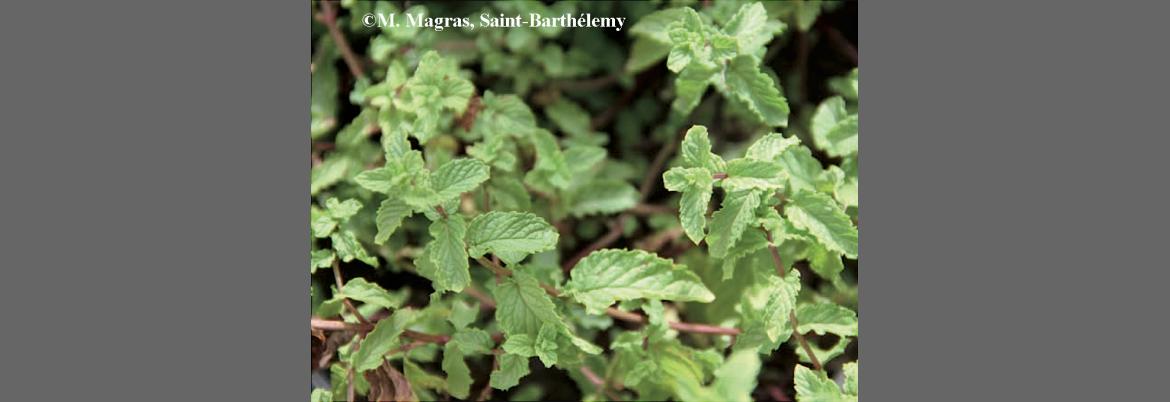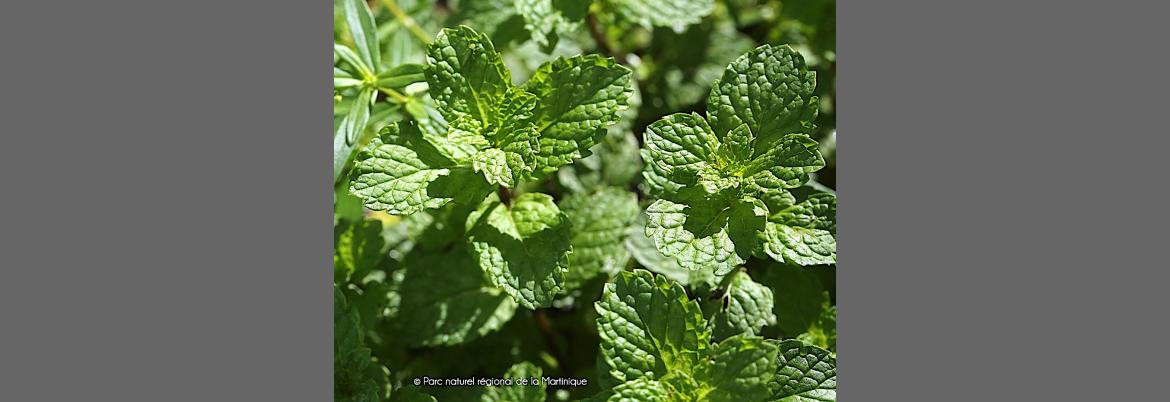1 DELENS M, 1990-92 Encuesta TRAMIL. Centro al Servicio de la Acción Popular CESAP, Caracas, Venezuela.
2 CARBALLO A, 1990 Encuesta TRAMIL. Centro de investigación de fitoterapia y medicina tradicional de Topes de Collantes, Trinidad, Cuba.
3 CHARLES C, 1988 TRAMIL survey. Movement for Cultural Awareness MCA, Roseau, Dominica.
4 EDOUARD JA, 1992 Enquête TRAMIL. Lycée agricole, Baie-Mahault, Guadeloupe.
5 LONGUEFOSSE JL, NOSSIN E, 1990-95 Enquête TRAMIL. Association pour la valorisation des plantes médicinales de la Caraïbe AVPMC, Fort de France, Martinique.
6 SOLIS P, CORREA M, GUPTA M, 1995 Encuesta TRAMIL (Comunidades afro-caribeñas). Centro de Investigaciones Farmacognósticas de la Flora Panameña CIFLORPAN, Facultad de Farmacia, Universidad de Panamá, Panamá, Panamá.
7 CANIGUERAL S, VILA R, RISCO E, PEREZ F, PORTILLO A, FREIXA B, MILO B, VANACLOCHA B, RIOS JL, MORALES MA, ALONSO JR, BACHILLER LI, PERIS JB, STUBING G, 2002 Mentha sp. Vademecum de Fitoterapia, Editorial Masson, Barcelona, España, Nov. 20, 2003. URL: http://www.masson.es/book/fitoterapia.html
8 TAYLOR BA, DUTHIE HL, LUSCOMBE DK, 1985 Mechanism by which peppermint oil exerts its relaxant effect on gastrointestinal smooth muscle. J Pharm Pharmacol 37(Suppl):104.
9 GUEDON DJ, PASQUIER BP, 1994 Analysis and distribution of flavonoid glycosides and rosmarinic acid in 40 Mentha xpiperita clones. J Agr Food Chem 42(3):679-684.
10 HERRMANN EC, KUCERA LS, 1967 Antiviral substances in plants of the mint family (Labiatae). 3. Peppermint (Mentha piperita) and other mint plants. Proc Soc Exp Biol Med 124(3):874-878.
11 KIUCHI F, NAKAMURA N, MIYASHITA N, NISHIZAWA S, TSUDA Y, KONDO K, 1989 Nematocidal activity of some anthelmintic traditional medicines and spices by a new assay method using larvae of Toxocara canis. Shoyakugaku Zasshi 43(4):279-287.
12 LESLIE GB, 1978 A pharmacometric evaluation of nine bio-strath herbal remedies. Medita 8(10):3-19.
13 DELLA LOGGIA R, TUBARO A, LUNDER TL, 1990 Evaluation of some pharmacological activities of a peppermint extract. Fitoterapia 61(3):215-221.
14 DELLA LOGGIA R, TUBARO A, REDAELLI C, 1981 Valutazione dell'attività sul S.N.C. del topo di alcuni estratti vegetali e di una loro associazione. (Evaluation of the activity on the mouse CNS of several plant extracts and a combination of them). Rivista di Neurologia 51(5):297-310.
15 COSTA M, DI STASI LC, KIRIZAWA M, MENDACOLLI SL, GOMES C, TROLIN G, 1989 Screening in mice of some medicinal plants used for analgesic purposes in the state of Sao Paulo. Part II. J Ethnopharmacol 27(1-2):25-33.
16 ROSS S, EL-KELTAWI N, MEGALLA S, 1980 Antimicrobial activity of some Egyptian aromatic plants. Fitoterapia 51:201-205.
17 SCORTICHINI M, ROSSI M, 1989 In vitro activity of some essential oils toward Erwinia amylovora (Burril) Winslow. Acta Phytopathol Entomol Hung 24(3/4):421-431.
18 RAI MK, UPADHYAY S, 1988 Laboratory evaluation of essential oil of Mentha piperita Linn. against Trichophyton mentagrophytes. Hindustan Antibiot Bull 30(3-4):82-84.
19 HARRIES N, JAMES KC, PUGH WK, 1978 Antifoaming and carminative actions of volatile oils. J Clin Pharmacol 2:171-177.
20 TADDEI I, GIACHETTI D, TADDEI E, MANTOVANI P, BIANCHI E, 1988 Spasmolytic activity of peppermint, sage and rosemary essences and their major constituents. Fitoterapia 59(6):463-468.
21 MELZIG M, TEUSCHER E, 1991 Investigations of the influence of essential oils and their main components on the adenosine uptake by cultivated endothelial cells. Planta Med 57(1):41-42.
22 LAM L, ZHENG B, 1991 Effects of essential oils on glutathione S-transferase activity in mice. J Agr Food Chem 39(4):660-662.
23 BRIGGS C, 1993 Peppermint: medicinal herb and flavouring agent. Can Pharmaceutical J 126(2):89-92.
24 DALVI SS, NADKARNI PM, PARDESI R, GUPTA KC, 1991 Effect of peppermint oil on gastric emptying in man: A preliminary study using a radiolabelled solid test meal. Indian J Physiol Pharmacol 35(3):212-214.
25 MAY B, KUNTZ HD, KIESER M, KOHLER S, 1996 Efficacy of a fixed peppermint oil/caraway oil combination in non-ulcer dyspepsia. Arzneimittel Forschung [Drug Research] 46(12):1149-1153.
26 BEZIAT M, 1983 Toxicité d'huiles essentielles. Thèse Pharmacie, Montpellier, France.
27 CODE OF FEDERAL REGULATIONS, 2002 Food and drugs. Chapter I - Food and Drug administration, Department of Health and Human Services. Part 182 - Substances generally recognized as safe. Sec. 182.10. Spices and other natural seasonings and flavorings. U.S. Government Printing Office via GPO Access, USA. 21(3):451-452. Feb. 24, 2003, URL: http://www.accessdata.fda.gov/scripts/cdrh/cfdocs/cfcfr/CFRSearch.cfm?CF...
28 VIZOSO A, RAMOS A, VILLAESCUSA A, DECALO M, BETANCOURT J, 1997 Estudio genotóxico in vitro e in vivo en tinturas de Melissa officinalis L. (toronjil) y Mentha piperita L. (toronjil de menta). Rev Cub Plantas Med 2(1):6-11.
29 MICROMEDEX T, 2003 Healthcare Series. Vol. 117. 9/2003 Thomson MICROMEDEX®.
30 BUDAVARI S (Ed.), 2001 The Merck index: an encyclopedia of chemical, drugs, and biologicals. 30th ed. New Jersey, USA: Merck and Co., Inc. p1043-1044.
31 SIVASWAMY SM, BALACHANDRAN B, BALANEHRU S, SIVARAMAKRISHNAN VM, 1991 Mutagenic activity of south Indian food items. Indian J Exp Biol 29(8):730-737.
32 WICHTL M, 1999 Plantes thérapeutiques. Tec and Doc. p365.
33 ALONSO J, 1998 Tratado de fitomedicina: bases clínicas y farmacológicas. Buenos Aires, Argentina: ISIS ediciones SRL. p721.
34 MARTINEZ MJ, MOREJON Z, LOPEZ M, BOUCOURT E, FUENTES V, MORON F, 2005 Clases tóxicas agudas (CTA) de una decocción de hoja fresca de Mentha nemorosa Willd.Informe TRAMIL. Laboratorio Central de Farmacología, Facultad de Ciencias Médicas “Dr. Salvador Allende”, La Habana, Cuba.
35 GUERRA MJ, LOPEZ M, BOUCOURT E, FUENTES V, MORON F, 2002 Clases tóxicas agudas en rata de decocción (30%) de hojas secas de Mentha x piperita varcitrata (Ehrh.) Briq.Informe TRAMIL. Laboratorio Central de Farmacología. Facultad de Medicina Dr. Salvador Allende. Ciudad de La Habana, Cuba.
36 GUERRA MJ, LOPEZ M, BOUCOURT E, FUENTES V, 2002 Toxicidad aguda (DL50) en ratón de la decocción de hojas secas de Mentha x piperita var citrata(Ehrh.) Briq.Informe TRAMIL. Laboratorio Central de Farmacología. Facultad de Medicina Dr. Salvador Allende. Ciudad de La Habana, Cuba.
37 BALZ E, BOYER A, BURAUD M, 2007 Enquête TRAMIL à Marie-Galante. U. Bordeaux 3, U. Paris XI Chatenay-Malabry, UAG, Guadeloupe.
38 OCRISSE G, 2008 Enquête TRAMIL auprès de 250 familles de la moitié Est de la partie francophone de St Martin. Biologie végétale, UAG, Guadeloupe.










